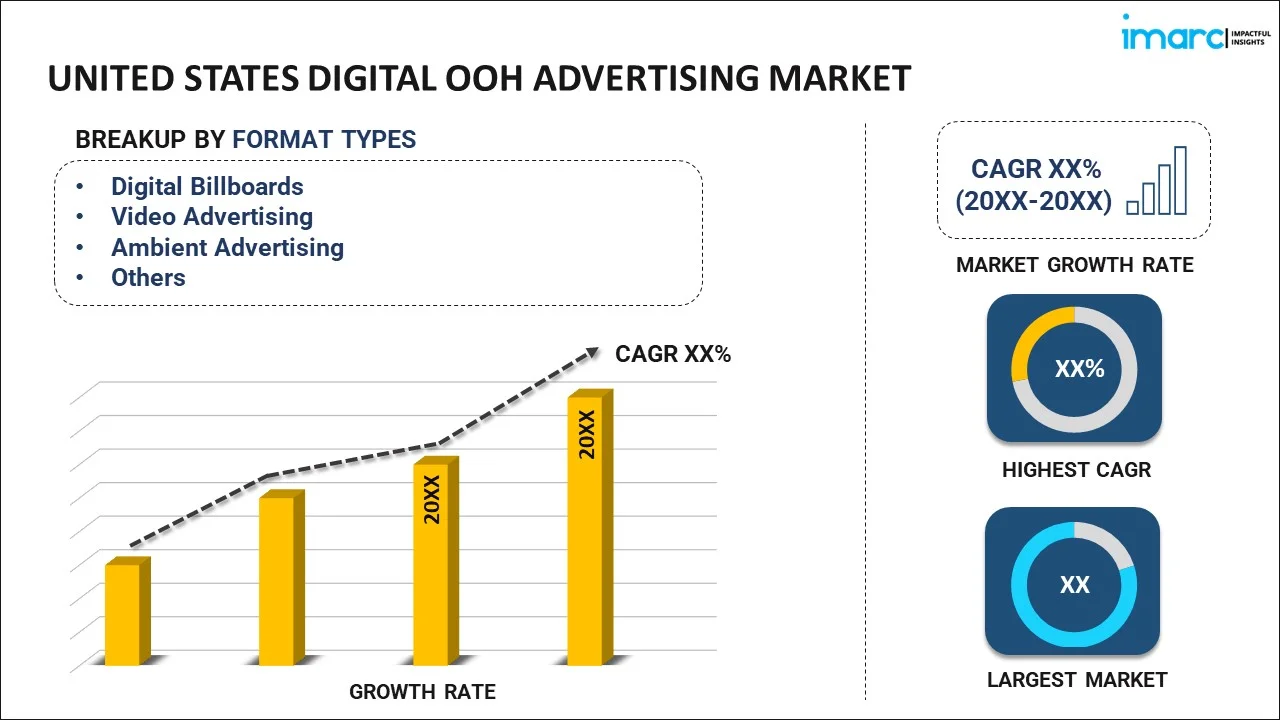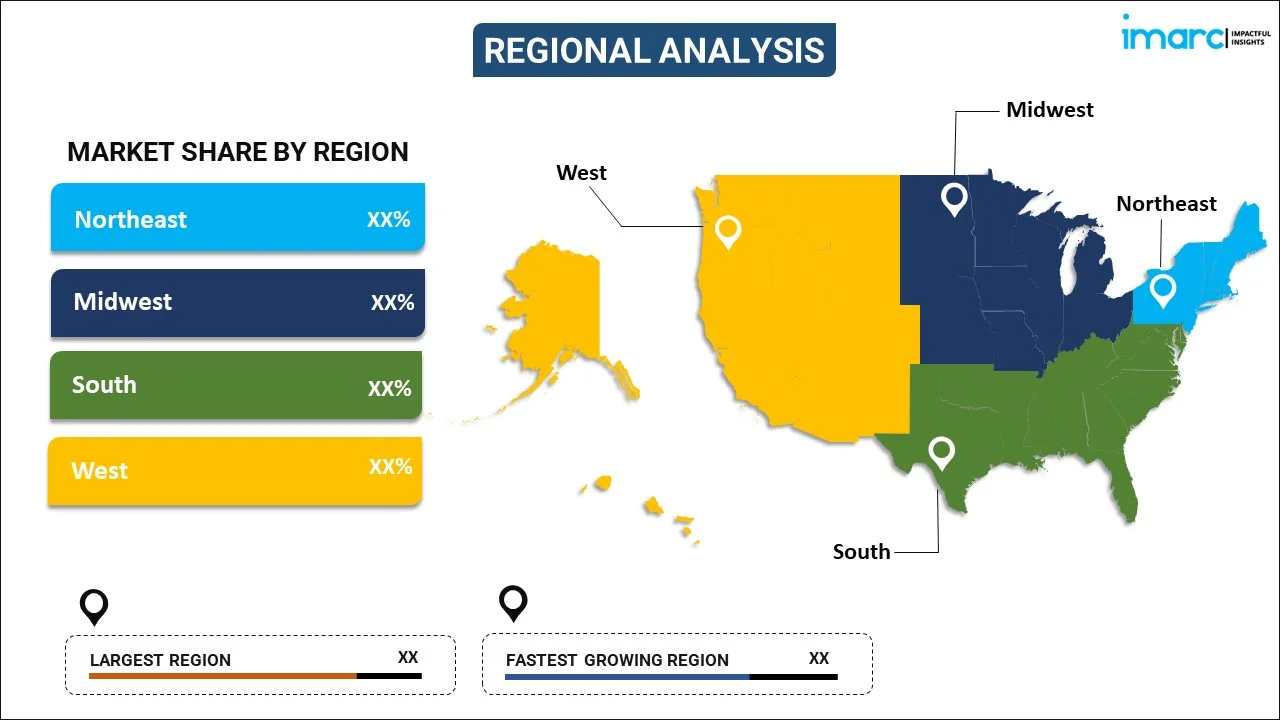
United States Digital OOH Advertising Market Report by Format Type (Digital Billboards, Video Advertising, Ambient Advertising, and Others), Application (Outdoor, Indoor), End Use Industry (Retail, Recreation, Banking, Transportation, Education, and Others), and Region 2025-2033
Market Overview:
The United States digital OOH advertising market size reached USD 6.1 Billion in 2024. Looking forward, IMARC Group expects the market to reach USD 14.7 Billion by 2033, exhibiting a growth rate (CAGR) of 9.79% during 2025-2033.
|
Report Attribute
|
Key Statistics
|
|---|---|
|
Base Year
|
2024
|
|
Forecast Years
|
2025-2033
|
|
Historical Years
|
2019-2024
|
|
Market Size in 2024
|
USD 6.1 Billion |
|
Market Forecast in 2033
|
USD 14.7 Billion |
| Market Growth Rate (2025-2033) | 9.79% |
Digital OOH (out-of-home) advertising includes digital billboards, small digital signs, outdoor signage and display screens, which are accessible to the public. It is generally installed at airports, railway stations, bus shelters, medical waiting rooms, shopping malls, retail stores, movie theatres and roadways to advertise goods and services. At present, advertisers in the United States are using virtual screens, projectors, motion graphics and video content to target specific demographics.
Technological advancements, along with the presence of numerous shopping complexes and malls, represent one of the key factors spurring the market growth in the United States. Apart from this, digital display expansion, increasing media fragmentation, improving audience measurement, and rising traffic congestion and travel time are some of the other major factors contributing to the market growth. Furthermore, technological advancements in display technologies, such as miniaturization and rollout of micro light-emitting diodes (LEDs), are escalating the demand for digital OOH advertising in the country. However, as the US Government has announced lockdown, it is encouraging the adoption of social distancing measures to minimize the transmission of the coronavirus disease (COVID-19). This led to the temporary closure of public places and transportation facilities, such as airports, buses, railway stations, shopping malls and movie theatres, which, in turn, negatively impacted the market growth.
Key Market Segmentation:
IMARC Group provides an analysis of the key trends in each segment of the United States digital OOH advertising market report, along with forecasts at the regional and country level from 2025-2033. Our report has categorized the market based on format type, application, and end use industry.
Breakup by Format Type:

- Digital Billboards
- Video Advertising
- Ambient Advertising
- Others
Breakup by Application:
- Outdoor
- Indoor
Breakup by End Use Industry:
- Retail
- Recreation
- Banking
- Transportation
- Education
- Others
Breakup by Region:

- Northeast
- Midwest
- South
- West
Competitive Landscape:
The competitive landscape of the industry has also been examined along with the profiles of the key players.
Report Coverage:
| Report Features | Details |
|---|---|
| Base Year of the Analysis | 2024 |
| Historical Period | 2019-2024 |
| Forecast Period | 2025-2033 |
| Units | Billion USD |
| Segment Coverage | Format Type, Application, End Use Industry, Region |
| Region Covered | Northeast, Midwest, South, West |
| Customization Scope | 10% Free Customization |
| Post-Sale Analyst Support | 10-12 Weeks |
| Delivery Format | PDF and Excel through Email (We can also provide the editable version of the report in PPT/Word format on special request) |
Key Questions Answered in This Report:
- How has the United States digital OOH advertising market performed so far and how will it perform in the coming years?
- What has been the impact of COVID-19 on the United States digital OOH advertising market?
- What are the key regional markets?
- What is the breakup of the market based on the format type?
- What is the breakup of the market based on the application?
- What is the breakup of the market based on the end use industry?
- What are the various stages in the value chain of the industry?
- What are the key driving factors and challenges in the industry?
- What is the structure of the United States digital OOH advertising market and who are the key players?
- What is the degree of competition in the industry?
Need more help?
- Speak to our experienced analysts for insights on the current market scenarios.
- Include additional segments and countries to customize the report as per your requirement.
- Gain an unparalleled competitive advantage in your domain by understanding how to utilize the report and positively impacting your operations and revenue.
- For further assistance, please connect with our analysts.
 Inquire Before Buying
Inquire Before Buying
 Speak to an Analyst
Speak to an Analyst
 Request Brochure
Request Brochure
 Request Customization
Request Customization




.webp)




.webp)












